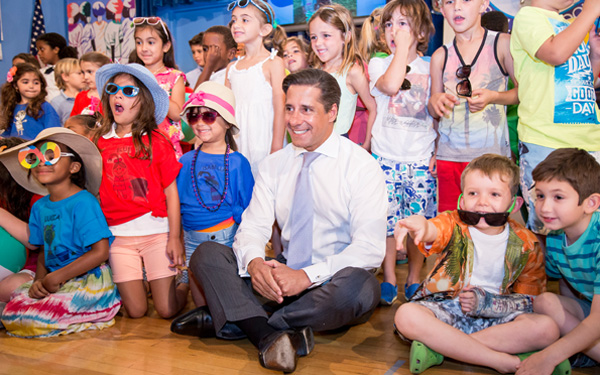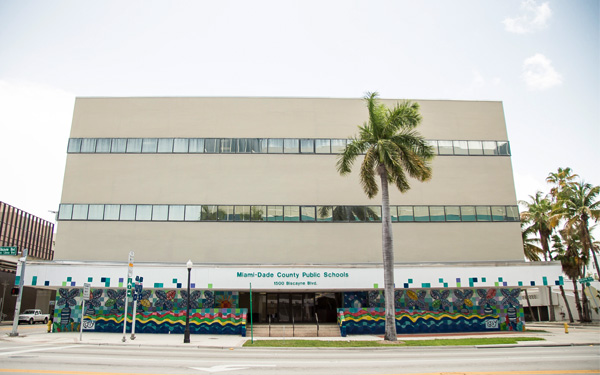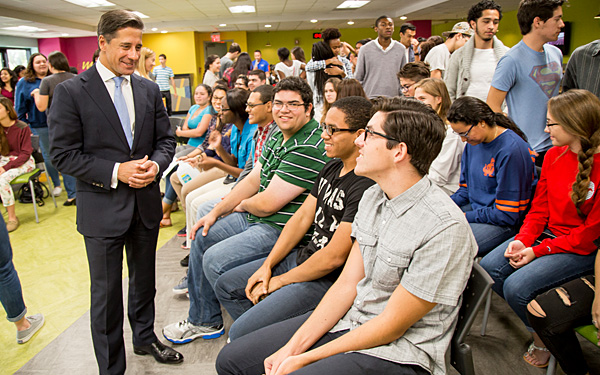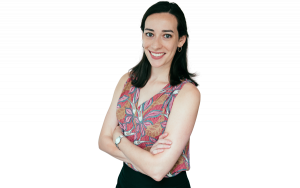Everything is a little different at iPreparatory Academy.
There are no bells ringing through the hallways, no athletics programs and no school buses. The 730 students go to class in a former Jefferson’s department store building in the city’s business district, cordoned between an interstate highway and the Atlantic Ocean.
And they have a principal who is only around about 10 percent of the time, because he also happens to be the superintendent of Miami-Dade County Public Schools, the fourth-largest school district in the country.
iPrep is a magnet school — free, public (though students must apply to enroll) and with a special focus on technology in the high school and international studies in the lower grades.
It is the fast-growing prototype in a bold plan by Superintendent Alberto Carvalho to offer all students in the sprawling urban district an alternative to the “traditional” public education experience.
The idea is that giving students the option to learn at their own pace while holding them to high standards will lead to academic success.
“What I am proving is, No. 1: One size fits none,” Carvalho says. “A need creates schools that provide for independent, personalized, individualized learning journeys for all students.”
Carvalho, 50, took over the district of 355,000 mostly minority students in 2008 and has since shepherded it through a period of remarkable growth, with the school choice expansion experiment at the forefront.
In Miami-Dade, 90 percent of students are minority, nearly three-quarters — 72 percent — are lower income and many enter school with little or no English language skills. It’s a struggle that Carvalho has lived himself: He emigrated to the U.S. from his native Portugal when he was 17, speaking no English. He was the first in his family to graduate from high school.
“I was the proverbial unaccompanied minor,” he said, recalling his youth in Lisbon and the decision to leave his family for the chance of better opportunities in America. To support himself, he worked as a busboy and a day laborer.
His moment to get ahead came through a chance encounter with E. Clay Shaw Jr., the late Republican congressman, whom he served at a restaurant during Shaw’s early years in office. Shaw took a liking to the young Carvalho and helped him get a student visa and a work permit. He encouraged him to apply to community college, where he obtained a scholarship.
“Rather than decrying the crisis, we embraced the crisis as an incredible opportunity to press the reset button as a school system”
Fast-forward about 30 years. Under Carvalho’s leadership, the number of magnets, charters and “choice” schools in Miami-Dade has exploded and growing numbers of students are opting to enroll. Roughly 62 percent of students—that’s more than 200,000 kids—will attend one of these programs in the 2015-16 school year, either in a separate, all-inclusive school like iPrep or a part-time program within a traditional neighborhood school. Some 30 new programs open each year, ranging in specialty from conservation biology to the performing arts to vocational training.
iPrep is actually currently composed of two smaller schools operating in the same building. The lower school, initially called the Primary Learning Center, opened with a few dozen students in 2009 and now caters to students in pre-kindergarten through 5th grade; the iPreparatory Academy high school opened a year later with one 11th grade class. Carvalho appointed himself the principal of both schools and handpicked administrators from within the district who were eager to use new technology in the classroom.
In the high school, students can be found sprawled on bean bags or colorful carpets and huddled in small groups — each on their own MacBook computer — working through a combination of teacher-led assignments and online instruction at their own pace. Teachers trained in the techniques of blended learning facilitate and supervise students’ computer activity, but you won’t see them lecturing in front of children sitting in rows.
Educators say mixing highly motivated students of different skill levels in a competitive environment that’s been designed for independent learning forces them to turn to each other when they need help.
“The students choose to come here and they know the courses are hard,” said Layda Nasr, the assistant principal at the high school. “You don’t have to be the smartest, but it’s a place for students who actually want to succeed and want to do well in school and are motivated.”
High schoolers must have a 2.5 GPA to be accepted and maintain that while enrolled, Nasr said. If they don’t meet standards for both academic and behavioral performance, they can be asked to leave.
Hector Rodriguez, 17, said that as a freshman he wasn’t prepared to manage his own time and seek out information like homework assignments without prompts from teachers.
Now a rising senior, Rodriguez is thriving while taking mostly Advanced Placement courses and completing an internship, as all upper-level students are required to do. His is at a local law firm. The teen said he enjoys the rigor of iPrep and can see where it’s forced him to improve.
“Over time, I’ve come to appreciate it and so have my classmates,” he said.
His mother, Lisette Ledesma, said iPrep combines the best of both the public- and private-school worlds.
“You have less chance of your kid going the wrong way or making wrong decisions,” when they’re surrounded by like-minded peers, she said. “All the students were all in the same mindset, excelling, working toward college.”
On another floor of the building is the Primary Learning Center, where pre-k to fifth-grade classes study the culture, food and languages of different continents. All students are required to take an hour of Spanish language instruction each day. Opting for a third or fourth language is encouraged.
International visitors regularly observe classrooms through two-way mirrors, listening in with headphones, so they can replicate the teaching methods in their own schools.
Catherine Lopez Verdier, a fourth-grade teacher, said any awkwardness about being observed by strangers — or having the superintendent walk into your classroom without notice — fades pretty quickly. In a district with some 25,000 teachers and 46,000 staffers overall, getting face-time with the boss doesn’t come easy, for better or worse.
“It’s actually an opportunity to put your skills on display,” said Lopez Verdier, who also has a son entering first grade at the school.
So far, the iPrep experiment has earned high marks: 100 percent of seniors graduated in 2012 and 2015. Those were the only two years the high school had a full cohort, with about 45 kids in each graduating class. For 2014-15, the high school earned an “A” grade from the state of Florida, the top grade schools can receive.
Buoyed by this success, the two schools will officially merge next month, combining to form an iPrep with enrollment of more than 730 students and a wait list that exceeds 900. Each year, a middle grade is added — this fall it will be sixth grade — and eventually iPrep will become the first pre-K-12 school of its kind in the district.
If Carvalho has his way, this is just the beginning.
“It’s working so powerfully for the students at iPrep that it must become the reality for all students, as an option,” he said. “And if it works in Miami — where the student profile in terms of poverty and diversity, English language limitation, is extremely high — if it can work in Miami, it must be able to work anywhere else in America and I think we’re proving that.”
From bankruptcy fears to breakthroughs
The landscape in Miami-Dade looked starkly different in 2008, when Carvalho was promoted to superintendent after working as an assistant superintendent, chief communications officer, district lobbyist, and science and math teacher.
The district was near bankruptcy. The state was threatening to permanently close nine failing high schools and the graduation rate was lagging behind the state average. School board meetings devolved into fights.
It was, according to Carvalho, “a downward spiral that could have collapsed the fourth-largest school district in America.”
His first move was to fire 55 percent of administrative staff and pour the savings into student programs.
Today the district’s $4.8 billion budget is balanced. The high schools once under threat of closure have all remained open and made improvements. Graduation rates have soared 15 percentage points — from 62 percent in 2008-09 to 77 percent in 2012-13— surpassing neighboring districts, Carvalho said. More students are enrolled in Advanced Placement courses and dual enrollment programs that let them earn college credits. And all schools now have Wi-Fi.
“Rather than decrying the crisis, we embraced the crisis as an incredible opportunity to press the reset button as a school system and this led to immediate efficiencies; efficiencies led to targeted innovation and innovation over time became deep-rooted transformation,” Carvalho said.
In 2012, Miami-Dade won the Broad Prize, the nation’s top award for urban schools. The prize, which came with $550,000 in college scholarships for high school seniors, recognizes districts that successfully narrow the achievement gap between white and minority students. Carvalho was named National Superintendent of the Year in 2014.
Despite the strides of the last few years, Miami-Dade is not immune to the familiar challenges of urban school districts. The schools face a steady drumbeat of violence. In late June, four North Miami Senior High School students were charged in an alleged gang rape of another student who is mentally disabled. Police say the teens lured the girl into a janitor’s closet while school was in session.
Student-on-student violence and weapons possession makes the news regularly, though Carvalho said the number of “critical incidents” has declined as the district has boosted security measures, including training for teachers and students on early identification of negative social behavior that could lead to school violence.
The district spends about $40 million, four times more than the state allocation, on school security, including its own police force, he said. It has an anonymous hotline where students can report threats and contraband via phone and social media.
“We cannot allow the isolated nature of these very disturbing incidents to paint the global picture of what happens in systems, whether it’s here in Miami or elsewhere in America,” he said.
Not everyone is totally enamored with the changes Carvalho has brought to Miami-Dade though Brian Peterson, an associate professor at Florida International University, says he is perhaps the only person in the city willing to criticize him publicly. Peterson writes an insidery email newsletter about district politics and news where he credits Carvalho with definite successes but also sees problems in other reforms.
Carvalho “has been like a miracle worker” since he started the job, getting school board members to cooperate with each other and the teachers union to agree to move ineffective educators out of the lowest-performing schools, Peterson said.
On the other hand, the “privatization” of Miami-Dade schools through Carvalho’s expansion of magnets and charters has left behind many of the neediest minority students who are still struggling in the inner-city’s traditional schools, Peterson said.
Peterson also chafes at the administration’s adoption of a tight-lipped communication style in the Carvalho era. He said the over-centralized power structure leaves little room for schools to exercise autonomy over critical decisions like hiring.
“If you’re protected by someone downtown (in the district office) you can probably stay principal (for as long as you want),” he said.
Peterson acknowledges that Carvalho’s charisma and increasingly high profile has led to speculation that he may eventually seek a state or national position.
“I wouldn’t be surprised if he ran for office,” Peterson said. “He’s at the top of the heap.”
As he enters his eighth year, Carvalho is among the longest-tenured superintendents in the nation’s top 10 largest school districts. He makes $335,000 a year under a contract that runs through 2020.
In an interview, he dismissed the notion of an early exit and emphasized his commitment to the Miami-Dade school community.
“Calls have come, but I have no interest at this point in considering anything else,” he said. “I’m still very much enjoying the ride.”
While doing so, he is a living example for students who refuse to be defined by the circumstances of their youth.
His daily preoccupation is with leading what he calls a “dual life” — one that his parents should have lived, had they had the opportunity; and the one that he wants “to realize for every single kid in Miami-Dade.”
“The kids who, after living through experiences like my own, overcoming poverty and immigration and even homelessness, side-by-side with those who were born here and should have the same God-given right to excellent education,” he said.
Get stories like these delivered straight to your inbox. Sign up for The 74 Newsletter


;)



